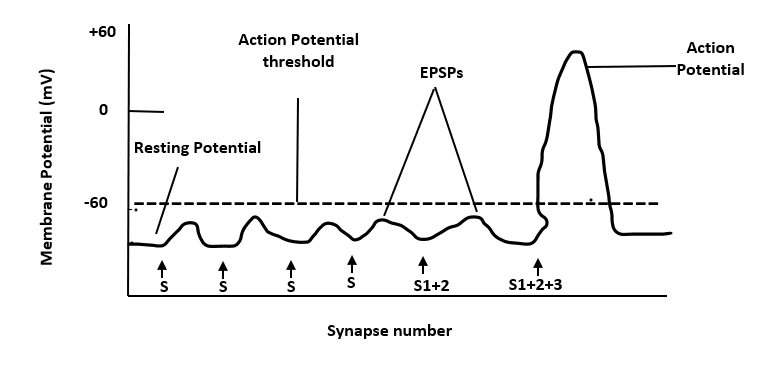
The neural phenomenon depicted by the given diagram is best described as:

A. Spatial summation
B. Temporal summation
C. Presynaptic excitation
D. Presynaptic inhibition

Answer
343.8k+ views
Hint:
Summation is the process of adding up. In the case of the nervous system, it is all about adding up the influence of several stimuli, which are uniquely subthreshold, so that together they are suprathreshold and can create an action potential (a response). There are two kinds of summation such as temporal summation and spatial summation which occur between neurons.
Complete answer:
The diagram reveals that three various stimuli arrive simultaneously and induce a huge EPSP that leads to an action potential, whereas less than three do not. This is a spatial summation. Temporal summation includes a similar stimulus that arrives in quick succession.
Spatial summation is the impact of triggering an action potential in a neuron by one or several presynaptic neurons. This happens when more than a single excitatory postsynaptic potential (EPSP) originates at the same time as another part of the neuron. If all the EPSPs are subthreshold then an action potential will not occur as soon as they reach the neuron individually. Though, if they all stimulate the neuron simultaneously at the trigger area, then the subthreshold EPSPs will sum up to produce a suprathreshold exceeding threshold voltage which will then generate an action potential.
Another type of spatial summation is that which involves an inhibitory postsynaptic potential (IPSP) that reaches the neuron while multiple EPSPs and the total of the IPSP and EPSP (the summed potential) is subthreshold, so no action potential is produced as the IPSP decreased EPSPs. Spatial summation in this example is referred to as postsynaptic inhibition.
Option ‘A’ is correct
Note:
Spatial summation is when gradually greater numbers of primary afferent (presynaptic) neurons are activated till an adequate neurotransmitter is discharged to activate action potential in the spinal cord (postsynaptic) neuron. The term is also used to define a rise in response resulting from the stimulation of larger regions or larger amounts of body tissue. Hence, pain rises in intensity as a function of this factor.
Summation is the process of adding up. In the case of the nervous system, it is all about adding up the influence of several stimuli, which are uniquely subthreshold, so that together they are suprathreshold and can create an action potential (a response). There are two kinds of summation such as temporal summation and spatial summation which occur between neurons.
Complete answer:
The diagram reveals that three various stimuli arrive simultaneously and induce a huge EPSP that leads to an action potential, whereas less than three do not. This is a spatial summation. Temporal summation includes a similar stimulus that arrives in quick succession.
Spatial summation is the impact of triggering an action potential in a neuron by one or several presynaptic neurons. This happens when more than a single excitatory postsynaptic potential (EPSP) originates at the same time as another part of the neuron. If all the EPSPs are subthreshold then an action potential will not occur as soon as they reach the neuron individually. Though, if they all stimulate the neuron simultaneously at the trigger area, then the subthreshold EPSPs will sum up to produce a suprathreshold exceeding threshold voltage which will then generate an action potential.
Another type of spatial summation is that which involves an inhibitory postsynaptic potential (IPSP) that reaches the neuron while multiple EPSPs and the total of the IPSP and EPSP (the summed potential) is subthreshold, so no action potential is produced as the IPSP decreased EPSPs. Spatial summation in this example is referred to as postsynaptic inhibition.
Option ‘A’ is correct
Note:
Spatial summation is when gradually greater numbers of primary afferent (presynaptic) neurons are activated till an adequate neurotransmitter is discharged to activate action potential in the spinal cord (postsynaptic) neuron. The term is also used to define a rise in response resulting from the stimulation of larger regions or larger amounts of body tissue. Hence, pain rises in intensity as a function of this factor.
Recently Updated Pages
What is glandular epithelium class 11 biology NEET_UG

The common characteristics between tomato and potato class 11 biology NEET_UG

Master Class 11 Economics: Engaging Questions & Answers for Success

Master Class 11 English: Engaging Questions & Answers for Success

Master Class 11 Social Science: Engaging Questions & Answers for Success

Master Class 11 Biology: Engaging Questions & Answers for Success

Trending doubts
What is BLO What is the full form of BLO class 8 social science CBSE

Which places in India experience sunrise first and class 9 social science CBSE

The shortest day of the year in India

What are the major means of transport Explain each class 12 social science CBSE

Which are the Top 10 Largest Countries of the World?

How many millions make a billion class 6 maths CBSE




